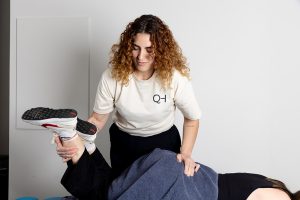Written by Riccardo Erba, BSc (Physiotherapy)
What if waves moving faster than the speed of sound could help your body heal? It might sound like science fiction, but this is exactly what Radial Shockwave Therapy (also known as Extracorporeal Shockwave Therapy, or ESWT) does—using high-energy sound waves to kickstart recovery in areas that need it most.
In this article, we’ll break down how shockwave therapy works, why it’s useful for stubborn tendon injuries, and what you need to know before considering it as part of your treatment plan.
Understanding Tendon Pain
Tendons are strong, rope-like tissues that connect muscle to bone. They’re built to handle load and movement, but they don’t always appreciate sudden changes.
If you’ve ever increased your exercise intensity too quickly, started a new activity, or trained without enough support from surrounding muscles, you might’ve irritated a tendon without even realising it.
It often begins as a dull ache before or after an activity. You might notice it fades as you warm up, but returns by the end of your session. Many of us brush this off until it gets in the way of doing what we love.
This early pain is your tendon saying, “Ease off—I need time to catch up.”
Why Tendons Don’t Always Recover Smoothly
From the moment you aggravate a tendon, your body gets to work. It starts repairing collagen fibres, communicates with your nervous system, and triggers inflammation which is a misunderstood but vital part of healing.
Inflammation brings blood flow and healing chemicals to the injured area. While it may cause swelling, soreness, or stiffness, it’s your body doing exactly what it’s supposed to do. That’s why we typically avoid anti-inflammatories in the first 48 hours post-injury as they can interfere with this crucial process.
But sometimes healing stalls.
Several factors can disrupt recovery, such as:
- Smoking or a poor diet
- Inadequate rest and poor sleep
- Diabetes or other chronic conditions
- Weakness in the surrounding muscles
- Improper footwear or training on hard surfaces
If healing becomes delayed, the tendon may remain painful, inflamed, or structurally compromised, with disorganised collagen fibres, hypersensitive nerves, and sluggish cell activity. It becomes a cycle: pain eases, then returns. And the longer it drags on, the harder it becomes to break.
How Shockwave Therapy Helps
Shockwave Therapy can be the game-changer when rest, exercise, massage, or bracing haven’t worked, and your tendon still refuses to heal.
Let’s say you’ve been diagnosed with tendinopathy. You’ve followed your program, but improvement has plateaued. This is often when shockwave therapy is introduced. It essentially gives your body the “push” it needs to restart the healing process.
Here’s how it helps:
- Stimulates tendon cells to produce and organise new collagen
- Increases blood flow by promoting new capillary growth
- Breaks down scar tissue and helps remodel disorganised fibres
- Reduces pain by calming inflammation and nerve sensitivity
Is Shockwave Therapy a Miracle Cure?
Not quite, but it’s a powerful tool when used at the right time.
Shockwave therapy is not a stand-alone solution. It works best when integrated into a broader treatment approach that addresses the root causes of your tendon pain, like poor biomechanics, weak supporting muscles, training load, footwear, or even your sleep quality.
In other words, it can’t fix the problem if the habits or conditions that caused it are left unchecked.
The Takeaway
Shockwave therapy offers a non-invasive, science-backed way to support tendon healing, especially when progress has slowed or stopped. It’s not magic, but it’s highly effective when paired with the right rehab strategy.
If your tendon pain has been lingering despite your best efforts, it may be time to explore whether shockwave therapy could be part of your recovery toolkit.




